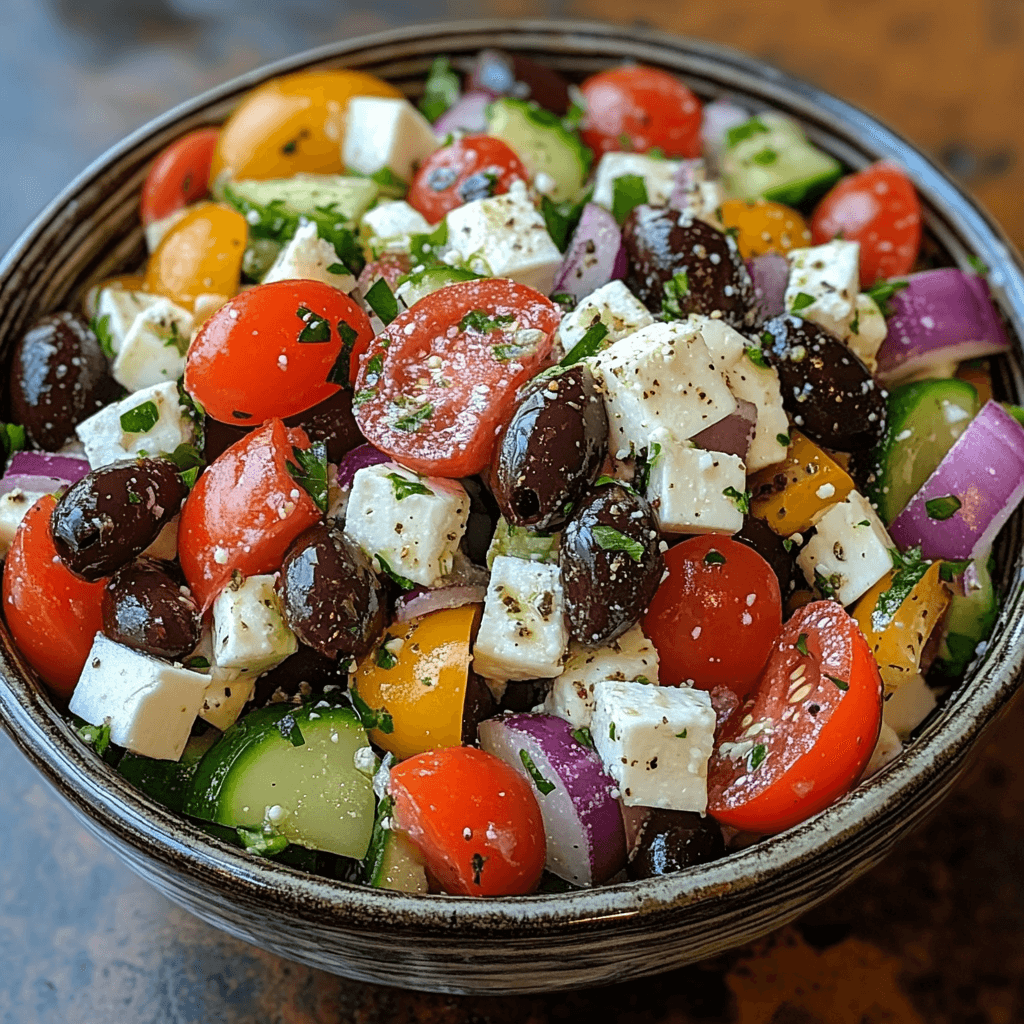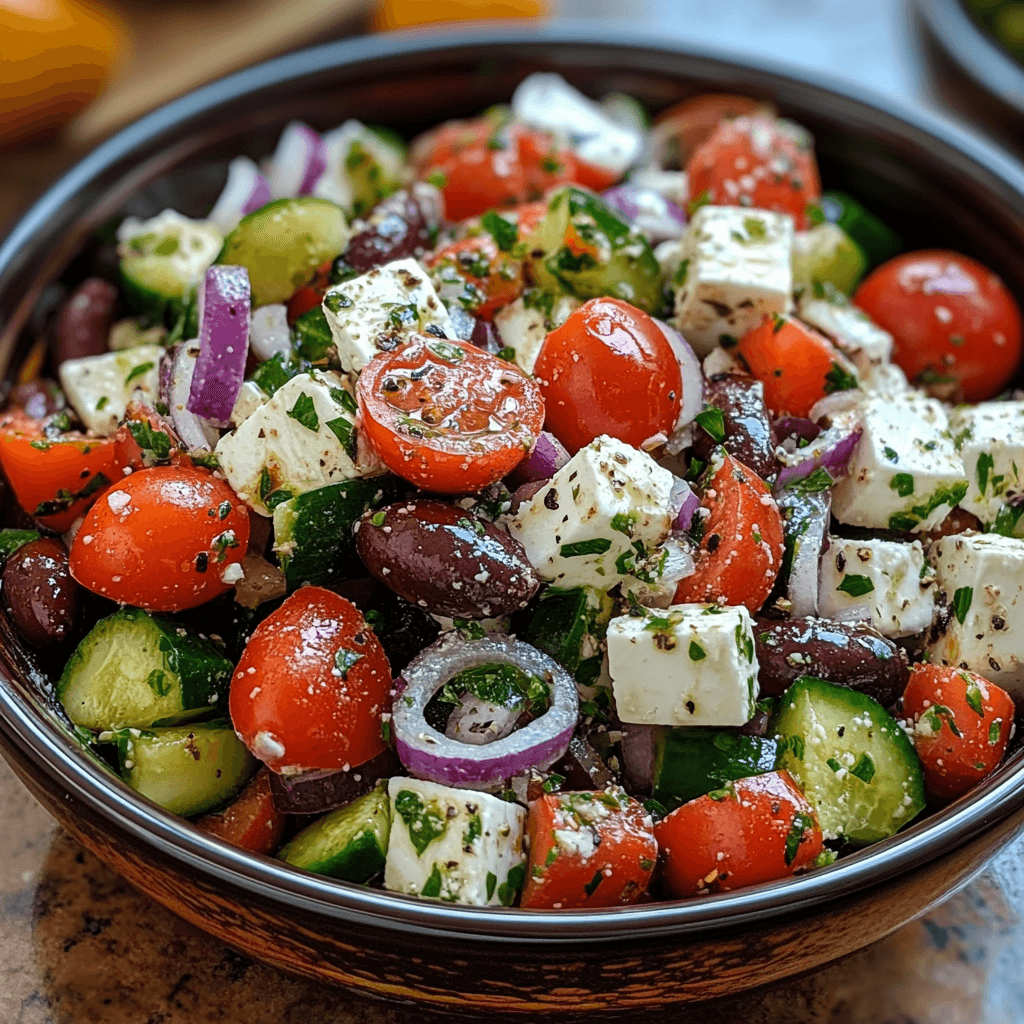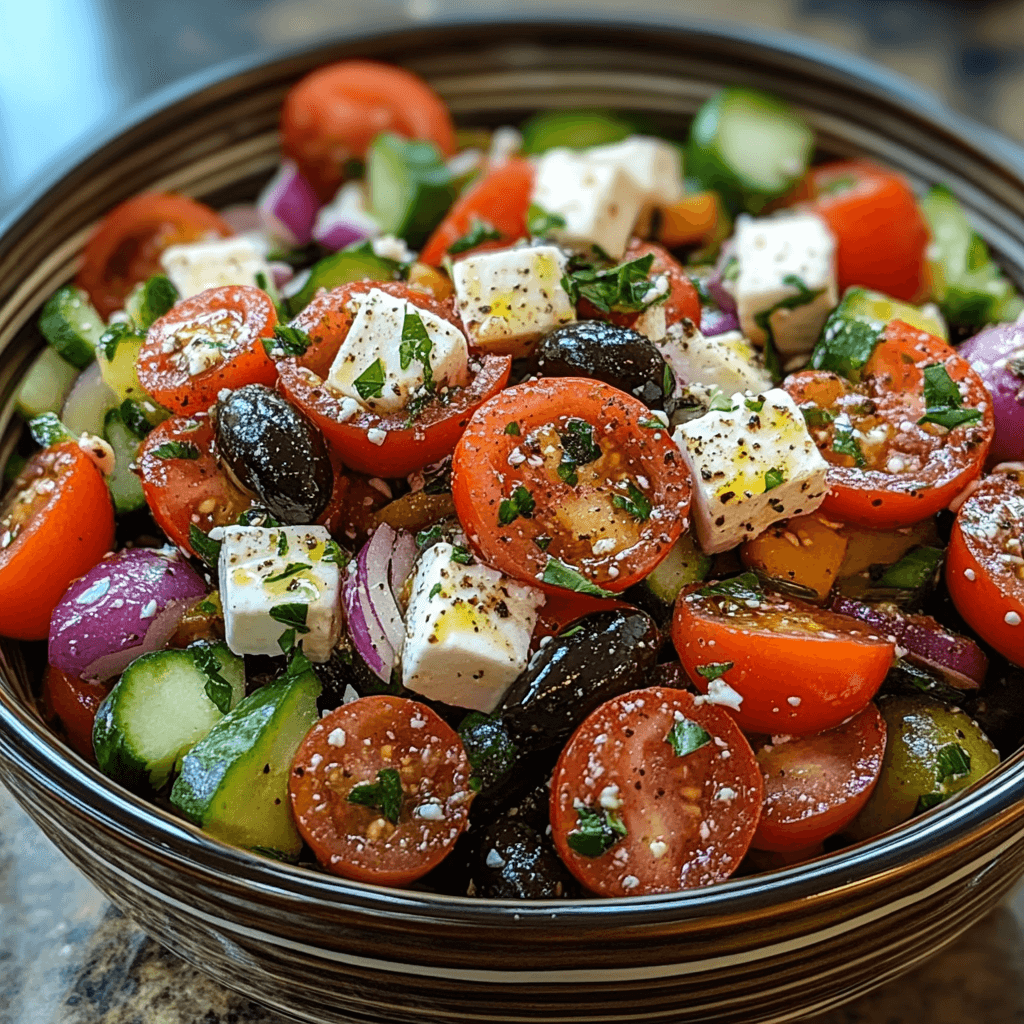Greek Salad, a colorful and refreshing dish, beautifully encapsulates the essence of Mediterranean cuisine. With its vibrant mix of crisp cucumbers, juicy tomatoes, aromatic herbs, and creamy feta cheese, this salad isn’t just a side dish—it’s a celebration of flavors. The versatility of the classic recipe opens avenues for delicious variations. Consider adding kalamata olives for a briny kick or grilled chicken for a heartier meal. Often, the perfect balance comes down to the quality of your ingredients; fresh, ripe produce and high-quality olive oil are key to achieving that authentic Greek taste.
For a delightful twist, experiment with seasonal vegetables or add grains like quinoa for added texture and nutrition. Don’t hesitate to enhance the dressing with a splash of lemon juice or a sprinkle of oregano to elevate the flavor profile. Whether served as a light lunch or a vibrant side at dinner, mastering this Mediterranean staple will surely impress your family and friends alike. Dive into our recipe to discover how to create your own remarkable Greek Salad at home!
Ingredients for Greek Salad:

Preparing a refreshing Greek salad that serves 8 to 10 people requires a balanced selection of fresh ingredients. Below is the detailed list to ensure that your dish bursts with authentic flavors.
Vegetables:
- 3 large ripe tomatoes, diced
- 1 medium cucumber, sliced into half-moons
- 1 red onion, thinly sliced (about 1 cup)
- 1 bell pepper (preferably green), chopped
- 2 cups of fresh parsley, roughly chopped
Cheese and Olives:
- 8 ounces of feta cheese, crumbled (or in blocks, for a firmer texture)
- 1 cup Kalamata olives, pitted and halved
Oils and Vinegar:
- 1/2 cup extra virgin olive oil (look for high-quality, cold-pressed for the best flavor)
- 1/4 cup red wine vinegar (or lemon juice for a zesty twist)
Herbs and Spices:
- 2 teaspoons dried oregano (Greek oregano is preferred)
- Freshly cracked black pepper to taste
- Sea salt, to taste (consider omitting if your feta is salty)
Suggested Variations:
You can customize your dish to suit different tastes by integrating some alternative ingredients:
- Add 1 cup of artichoke hearts for an extra tangy taste.
- For a spicy kick, include 1 diced jalapeño or a sprinkle of red pepper flakes.
- Include roasted red peppers for an additional layer of flavor and color.
- Consider using grilled vegetables like zucchini or eggplant for a heartier salad.
By integrating these ingredients into your Greek salad, you’ll ensure that each bite delivers a mix of vibrant colors, textures, and tastes. Enjoy the bold flavors that represent the essence of Mediterranean cuisine!
How to prepare Greek Salad:
Creating a fresh and vibrant Greek Salad requires a few simple ingredients and steps. Follow these instructions closely for the best results.
Gather Your Ingredients
Start by gathering all your ingredients. You will need: ripe tomatoes, crisp cucumbers, red onions, Kalamata olives, and feta cheese. Fresh herbs like oregano and parsley will add flavor, along with olive oil and vinegar for dressing.
Prepare the Vegetables
Begin with the tomatoes. Wash them thoroughly, then cut them into bite-sized pieces. Place the chopped tomatoes in a large salad bowl.
Next, take a cucumber. Peel it if the skin is tough, then slice it into rounds or half-moons, depending on your preference. Add the cucumber slices to the bowl with tomatoes.
Now, slice the red onion. You can cut it into thin rings or small pieces, depending on how strong you want the onion flavor to be. Add the red onion to the salad bowl.
Incorporate Olives and Cheese
Open a jar of Kalamata olives. If desired, you can pit them for easier eating. Toss the olives into the salad bowl, creating a nice contrast with the other ingredients.
Next, crumble or dice the feta cheese. Sprinkle it generously over the top of your salad. The saltiness of the feta complements the other fresh flavors perfectly.
Add Herbs and Seasonings
For a burst of flavor, finely chop fresh parsley and sprinkle it over the salad. Use dried oregano as well, adding a teaspoon or so to enhance the taste.
Dress the Salad
In a separate bowl, mix together olive oil, red wine vinegar, salt, and pepper. Drizzle this dressing over the salad ingredients. Start with about three tablespoons of olive oil and one tablespoon of vinegar, adjusting to taste.
Combine and Serve
Gently toss all the ingredients together, making sure everything is well-coated with the dressing. Allow the salad to sit for a few minutes to let the flavors meld.
Finally, serve your Greek Salad fresh with crusty bread on the side or as a refreshing side dish to complement grilled meats. Enjoy the vibrant flavors!

Tips for the Perfect Greek Salad
Maintain the Right Temperature
To enjoy your salad at its best, keep it chilled before serving. Assemble the ingredients ahead of time, but do not add the dressing until just before serving. This helps maintain the crispness of the vegetables. For an extra touch, place your serving bowl in the fridge for about 30 minutes before adding the salad. If you’re serving outdoors or at a warm environment, consider using a large bowl filled with ice underneath your salad bowl to keep ingredients cool.
Focus on Quality Ingredients
The secret to a delicious salad lies in the ingredients. Choose ripe tomatoes, crisp cucumbers, and fresh bell peppers. Opt for extra virgin olive oil because its quality affects the overall flavor. If possible, select authentic feta cheese from Greece, as it has a distinct taste that elevates the dish. Don’t forget to include Kalamata olives, which offer a unique brininess that complements the fresh vegetables wonderfully.
Substitutions for Dietary Restrictions
If you need to accommodate specific dietary concerns, there are several suitable substitutions. For a vegan or dairy-free option, skip the feta or use a plant-based cheese alternative. If you’re watching your carb intake, consider adding sliced avocado in place of the starchy elements. For gluten-sensitive individuals, ensure that all packaged ingredients, like olives, are gluten-free and consider serving the salad with gluten-free bread on the side.
Additional Flavor Enhancements
Consider adding fresh herbs for a burst of flavor. Chopped basil or oregano can enhance the traditional taste. You might also explore different dressings. While the classic olive oil and vinegar mix is delightful, a lemon and herb vinaigrette can add a zesty twist. Pine nuts or sunflower seeds can introduce a crunchy texture, providing more depth to every bite.
Presentation Matters
Lastly, take a moment to consider how you present your salad. Layer the ingredients in a large bowl or individual plates for an appealing visual. A sprinkle of freshly cracked black pepper or a drizzle of balsamic reduction can elevate the dish’s presentation and flavor, making it as delightful to look at as it is to eat.
Storage Tips for Greek Salad:
Maintaining the freshness of your Greek salad is crucial for enjoying its vibrant flavors. Here are some practical storage tips that help you prolong its life and taste.
Optimal Storage Conditions
Store your Greek salad in a cool temperature. A refrigerator offers the best environment, keeping the ingredients fresh and crisp. Use an airtight container to minimize exposure to air, which can lead to wilting and spoilage. Moreover, keep the container sealed to protect the salad from absorbing strong odors from other foods in the fridge.
Separation is Key
When preparing Greek salad for storage, consider keeping certain ingredients separate. Lettuce, cucumbers, and tomatoes can release moisture, making other ingredients soggy. Store the dressing separately to maintain the salad’s crunch. Combine everything just before serving to preserve texture and flavor.
Proper Preparation and Freshness
Choose ripe vegetables when making your salad. Fresh produce enhances the salad’s taste and longevity. Wash and cut the vegetables just before storage, if possible. If not, store whole vegetables which tend to last longer and retain their quality.
Shelf Life of Ingredients
The shelf life of your Greek salad largely depends on its ingredients. Most components can stay fresh for 2 to 3 days in the refrigerator. However, if you notice any wilting or signs of spoilage, discard the affected items immediately. Feta cheese can typically last up to a week if kept in its brine, but check for off smells or changes in texture.
Using Leftovers Wisely
If you have leftover Greek salad, consider using it in different dishes. You can toss it into a wrap, add it to omelets, or serve it alongside grilled meats. This way, you reduce waste while enjoying its deliciousness in various ways.
By following these storage tips, you will keep your Greek salad fresher for longer and enjoy the delightful tastes of this Mediterranean classic even past its initial preparation.
Related Recipes to Explore
If you enjoy the fresh and vibrant flavors of a Mediterranean dish, you might like these recipes that share similarities or complement the essence of a traditional Greek salad.
- Tabbouleh: This Lebanese salad is rich in parsley, mint, tomatoes, and bulgur wheat. Like Greek salad, it offers a refreshing taste and uses fresh vegetables, making it a perfect side dish for summer meals. Its herbaceous profile pairs well with grilled proteins, enhancing your dining experience.
- Caprese Salad: Originating from Italy, this salad features fresh mozzarella, ripe tomatoes, and basil, drizzled with balsamic glaze. Similar in its use of fresh ingredients, Caprese salad balances flavors beautifully. Both salads make excellent accompaniments to any Mediterranean dinner, providing a colorful and light side.
- Panzanella: This Tuscan bread salad utilizes day-old bread, ripe tomatoes, cucumbers, and onions, all tossed in a tangy vinaigrette. Its combination of bread and vegetables creates a hearty yet simple dish. Panzanella’s textures complement the crispness of salad, making it an exciting choice for casual lunches or picnics.

Each of these options highlights fresh, seasonal ingredients while delivering vibrant flavors. They not only capture the spirit of Mediterranean cuisine but also serve as delightful pairings for many meals, just like a classic Greek salad.
Frequently Asked Questions:
What are the main ingredients in a traditional Greek salad?
In a classic Greek salad, the primary components usually consist of ripe tomatoes, crisp cucumbers, vibrant bell peppers, red onions, and briny Kalamata olives. Feta cheese is a vital addition, providing a creamy texture and a salty flavor profile. The salad is often dressed with olive oil, red wine vinegar, and a sprinkle of oregano to elevate its taste.
Can Greek salad be customized?
Absolutely! One of the appealing aspects of this dish is its versatility. You can add or substitute ingredients based on personal preference or regional variations. Common modifications include incorporating artichokes, capers, or even proteins like grilled chicken or shrimp to enhance nutritional value and flavor.
Is Greek salad healthy?
Yes, this Mediterranean dish is considered very healthy! It is rich in vitamins, antioxidants, and healthy fats primarily due to the fresh vegetables and olive oil. Moreover, the inclusion of feta cheese provides a source of calcium and protein, making it a balanced option for many diets.
How can I make a Greek salad vegan?
To make a vegan version of this traditional dish, simply omit the feta cheese or replace it with a plant-based alternative. You can also add ingredients like chickpeas or avocado to maintain a creamy texture and boost the nutritional content while keeping the flavors fresh and vibrant.
What should I serve with Greek salad?
Greek salad pairs wonderfully with a multitude of dishes. It is commonly served alongside grilled meats, fish, or as part of a mezze platter featuring hummus, tzatziki, and pita bread. Its refreshing nature complements heavier dishes well, making it a versatile side option.
How long does Greek salad last in the fridge?
While this salad is best enjoyed fresh, it can last up to two days in the refrigerator if stored properly in an airtight container. To maintain its crispness, consider adding delicate ingredients like cucumbers and lettuce right before serving. However, it’s essential to note that the quality may decline over time due to the moisture from the dressing.
Conclusion:
Greek salad is a vibrant and refreshing dish that beautifully showcases the best of Mediterranean flavors. Its simplicity is one of its most appealing attributes, requiring just a few high-quality ingredients like ripe tomatoes, crisp cucumbers, tangy feta, and olives. Flexibility is another key factor; feel free to adapt the recipe by adding ingredients such as bell peppers, red onion, or even protein sources like grilled chicken or chickpeas, making it a versatile option for any meal. Customization allows you to experiment with dressings, whether it’s a classic olive oil and lemon blend or a zesty herb vinaigrette. By embracing these aspects, you can tailor Greek salad to suit your personal taste while maintaining its delicious heritage. Enjoy it as a side or a light main dish, and relish the delightful flavors that this classic Mediterranean salad brings to your table!

